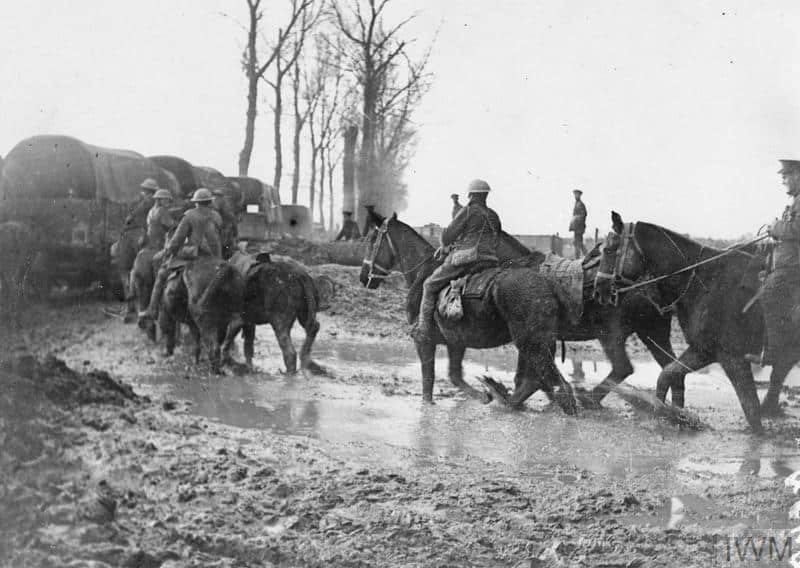Arras, 1917
The Battle of Arras was a British offensive on the Western Front during World War I. From 9 April to 16 May 1917, British troops attacked German defences near the French city of Arras on the Western Front. The British achieved the longest advance since trench warfare had begun, surpassing the record set by the French Sixth Army on 1 July 1916. The British advance slowed in the next few days and the German defence recovered. The battle became a costly stalemate for both sides and by the end of the battle, the British Third and First Army had suffered about 160,000 casualties and the German 6th Army about 125,000.
The Honour is borne on the Guidon of the 4th Hussars.
Scarpe
The Battle of the Scarpe refers to three battles that occurred during the Arras Offensive between 9 April and 4 May 1917.
The Honour was awarded to the 4th Hussars.
Detail
On the 5th April the 4th Hussars first marched to Hem and then on the 7th to Gaudiempre. it was here ‘A’ Echelon was brigaded and ‘B’ Echelon left behind at Occoches.
At 8.30 am on the 9th April they marched in a heavy snowstorm to the Arras end of the cavalry track. At 2.30 pm they proceeded up this, and formed up between Tilloy and Telegraph Hill. ‘C’ Squadron went on in advance of the brigade to clear a track through Tilloy.
The 4th Hussars remained on the battlefield at Telegraph Hill until 7 pm, when they then returned down the cavalry track reaching Angy about 2.30 am in heavy snow through very congested traffic. There they bivouacked in the open in the midst of the snow, with a cutting wind blowing.
At 10 am on the 10th they were ordered to stand-to at half an hour’s notice, and at 1.30 pm they were ordered to turn out, and were en route to to Telegraph Hill by 2 pm, reaching it around 3.30 pm. At 4 pm the brigade was ordered to a position of readiness west of Wancoun, on the report of the capture of that village. To get there it was necessary to come at a walk over shell-stricken ground, trenches, and wire, down a forward slope, in full view of the enemy until reaching the hollow south-west of Wancourt village.
‘C’ Squadron were again sent on in advance of the brigade to prepare a track, and reconnoitre the positions of our infantry. There was some shelling of the track, and ‘C’ Squadron were shelled on the forward slope north-west of Wancourt, which was still held by the enemy. This first report and subsequent ones of the capture of Wancourt all proved false.
‘C’ Squadron were lucky to come through the shelling with only two men wounded. When the regiment came on after them a timely snowstorm came on, hiding them from view, and they were not shelled. They remained in this hollow just behind the leading infantry in the tangled wire of the Hindenburg Line until 10 pm.
At 10 pm the Brigadier, General Bell-Smyth, having been given the choice of remaining there all night or of going back to water and feed and being in position again at 5 am the next day, chose the latter alternative, and we went back to Ronville, arriving there at 12.30 am. There was much snow and it was bitterly cold, while men and horses had to remain in the open, dead-beat, no fires and very little to eat, all night.
At 4am we returned to the position of the day-before, but this time hidden behind the shoulder of the hill in front of Neuville Vitasse. We were entirely unmolested, and at noon the Brigade closed up to the east on persistent reports of the fall of Wancourt while ‘D’ Battery came into action. At 3pm they were ordered to Angy.
On the march back it began to snow heavily again, and the horses were by now in a very bad state, eight dying. The regiment bivouacked in the open in some one inch of snow, blowing half a gale. During the day the horses were not watered.
On the 12th April at 1 pm the regiment marched to Gaudiempre. The horses only just capable of moving, owing to lack of food, exposure, and exhaustion, while the men were little better. During these three days they had two men wounded and lost twenty-four horses.
The 12th to the 18th were spent in billets. It was still cold, with rain and snow. The horses were in a very had way, and there was some sickness amongst the men from trench feet and exposure. On the 19th and 20th they marched to Le Boisle, where the billets much better.
The weather remained cold until the 28th when it grew warmer, and the horses improved. On the 28th the twenty-nine worst horses were cast. The horses of the regiment, however, did not properly recover from this expedition for a year.
They remained in billets here until the 11th May, when the dismounted men left by lorry.
From the 12th until the 18th of May the regiment marched via Wavans – Havernas – La Neuville – Suzanne to Marquaix.


